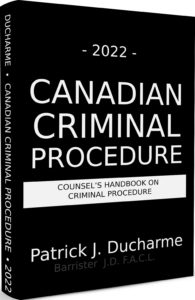
Evidence about what a person said or did after an offence has been committed may help a Judge or jury decide whether it was “that person” who committed the offence. It is evidence that may be used by a Judge or jury, along with other evidence, in deciding whether the Crown has proven guilt beyond a reasonable doubt.
Evidence of the actions of an accused after the offence has been committed is another form of circumstantial evidence. It therefore has only an “indirect” bearing on the issue of whether the accused is guilty of the offence. The evidence is indirect because it requires the trier of fact to draw inferences from it. This type of evidence may include destruction of physical evidence, fabricating an alibi or making false exculpatory statements to others so as not to be discovered as the perpetrator of a crime.

The above is the an excerpt of Patrick J Ducharme’s book, Canadian Criminal Procedure, available at Amazon or in bulk through MedicaLegal Publishing along with Criminal Trial Strategies.
Subscribe to Patrick Ducharme’s Youtube Channel
